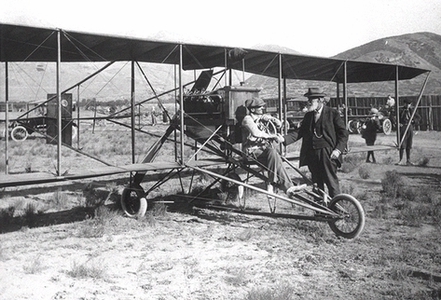PAYSON

Airplane in Payson, 1916
Payson, Utah County, is located about sixty miles south of Salt Lake City and nestles against the foothills of the southern Wasatch Range. It was colonized by a group of sixteen Mormon pioneers who settled near Peteetneet Creek in October 1850. They included James Pace, Andrew Jackson Stewart, John Courtland Searle, and their families. The settlement, which had been known as Peteetneet Creek, was renamed Payson in 1851 after James Pace. Payson was incorporated as a city on 21 January 1853. The settlement at that time included Spring Lake Villa to the south and Summit (Santaquin) to the southwest.
There were two major breaches of the peace between the native Ute Indians and the settlers during the early years. In July 1853 what became known as the Walker War began when an Indian shot and killed a guard outside of the fort at Payson. Skirmishes and encounters between the factions continued until May 1854 when a treaty of peace was entered into with Chief Wakara. Ten years of comparative peace followed. In June 1865 a treaty was established which stipulated that the Utes would be relocated on a reservation that had been established in Uintah County in eastern Utah. Chief Black Hawk and his followers were not willing to move and remained in Sanpete County. Conflict resulted and the ensuing Black Hawk War lasted for two years until a peace treaty was negotiated.
Payson primarily has been a farming community. Principal crops have always been grass hay, which the pioneers found growing wild when they arrived, lucerne (alfalfa), and grains such as wheat, barley, oats, and corn; beets, potatoes, and onions have also been grown. Cattle, sheep, and hogs are also raised in the area.
As the area grew, the supply of water became inadequate. However, additional water that became available following the construction and development of the Strawberry Reservoir brought new life to the area, with an increase in population and industrial development.
Payson, like other Mormon communities in Utah Territory, was nearly self-supporting. The people produced their own food and clothing, milled their own flour, operated their own sawmills, manufactured their own shingles, adobe bricks, and furniture. A millinery shop was established in 1906 and a floral shop in 1917. New industries continued to be established over the years, including manufacturing plants of motor homes, campers and trailers, and fiberglass boats.
While Mormons still predominate, religious diversity is found in Payson. The early settlers were members of the original Payson Ward, organized in 1851. There are now four LDS stakes in the Payson area, with a total of twenty-seven wards within these stakes. The Presbyterian Church established a mission and school in 1877. The school became known as one of the organization's best and largest schools, with pupils attending from both Presbyterian and Mormon homes. The school continued in operation until 1910, but church services were continued long after that. A Methodist church and school was constructed in Payson before the turn of the century, but discontinued operation prior to 1920. The Jehovah's Witnesses organized locally in 1973 and constructed a Kingdom Hall soon after that. More recently, the First Baptist Church of Payson was organized in 1980 and San Andres Catholic Church was established in 1986.
The population of Payson has grown from 427 persons in 1851 to 3,998 in 1950, 4,501 in 1970, and 9,510 in 1990. Payson's largest private employer is Mountain View Hospital, with over 400 employees, followed by Rayloc with more than one hundred. There are two elementary schools, a junior high school, middle school, and high school in the city.
Disclaimer: Information on this site was converted from a hard cover book published by University of Utah Press in 1994. Any errors should be directed towards the University of Utah Press.